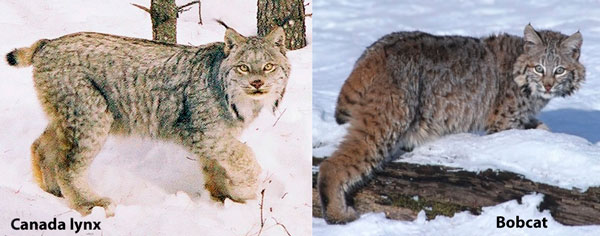 Canada Lynx are a state endangered and federally threatened species.
Canada Lynx are a state endangered and federally threatened species.
They are very similar in appearance and habits to bobcats, and their range overlaps with bobcats and other furbearer species. Knowing the difference between a lynx and a bobcat is critical to lynx survival.
Trappers or hunters who encounter lynx or lynx sign should quickly report their observations to wildlife biologist Brehan Furfey at (802) 952-8543.
It is important for trappers and hunters to be able to distinguish lynx from bobcats, to recognize their preferred habitat types, and to avoid capturing or harvesting lynx.
What Trappers Need to Know
- There are trapping regulations in WMU E1 and E2 designed to protect lynx.
- Lynx could be encountered outside of WMU E. All trappers should familiarize themselves with lynx sign and be prepared to adjust their methods to avoid incidentally capturing a lynx.
- Trappers who incidentally trap a lynx should release uninjured animals immediately and contact their local game warden as soon as possible. If an injury is suspected, trappers should contact their local game warden immediately for instructions on how to proceed.
Bobcat Hunting Methods to Help Avoid Taking Lynx
- Tracks should be closely examined and measured before any trailing dogs are released.
- Any treed bobcat should carefully be identified and confirmed as not being a lynx before it is harvested. A treed lynx should be abandoned immediately with harnessed dogs in tow.
- If predator calls are used in areas lynx may frequent, it is essential to identify and confirm any responding animals to assure a lynx is not shot.
- Since it may be difficult or impossible to positively identify a moving or partially hidden animal as a lynx or bobcat, it is best not to shoot at all whenever positive identity is unknown.
Key Identifying Features of Canada Lynx and Bobcat
Fur
- Lynx pelts are relatively bland and grayish.
- Bobcat pelts are reddish brown and have more distinct spots and streaks.
Tail
- Lynx tails appear much the same viewed top or bottom. The lynx tail tip is completely black all around.
- Bobcat tails show black bars with a white tip when viewed from above and show a lot of white underneath.
Hind Legs and Feet
- The hind legs of lynx are disproportionately longer, causing them to have a “stooped” appearance.
- Lynx feet are snowshoe-like and are at least twice the size of bobcat feet.
